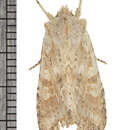Conservation Status
provided by University of Alberta Museums
A common widespread species.
- license
- cc-by-nc
- copyright
- University of Alberta Museums
Cyclicity
provided by University of Alberta Museums
In Alberta they emerge in fall (September-October), hibernate, and reappear in April and May.
- license
- cc-by-nc
- copyright
- University of Alberta Museums
Distribution
provided by University of Alberta Museums
Nova Scotia and New Brunswick west to Vancouver Island, south in the mountains both east and west. Found throughout the wooded parts of Alberta, north to Lake Athabasca.
- license
- cc-by-nc
- copyright
- University of Alberta Museums
General Description
provided by University of Alberta Museums
A medium size Lithophane (wingspan 3.5-3.9 cm). Forewings light ochre marked with a dull brown median shade and subterminal line. A dark grey bar-shaped patch, somewhat diffuse, in the lower median area. Suberminal line with a slight reddish shade before and a dark shade beyond. Hindwings dark grey, including most of the costal area, and with a dark discal spot and pale fringe. Abdomen tufted. Sexes alike. This is one of the commonest Lithophane at both light traps and bait. Like most Lithophane it is much more commonly collected in spring than in fall. Spring specimens are lighter in color (faded) than are freshly emerged fall specimens. The similar L. bethunei has been recorded west to central Saskatchewan and should be watched for in east central Alberta. It is a paler cream and tan, and can be separated by the cream hindwing with little gray scaling (grey in innominata).
- license
- cc-by-nc
- copyright
- University of Alberta Museums
Habitat
provided by University of Alberta Museums
Wooded areas.
- license
- cc-by-nc
- copyright
- University of Alberta Museums
Life Cycle
provided by University of Alberta Museums
The larvae are solitary defoliators on a wide variety of tree species. Like some other species in the genus, the larvae are reported to prey on other insects (Covell, 1984). Adults hibernate, and come to both bait and light.
- license
- cc-by-nc
- copyright
- University of Alberta Museums
Trophic Strategy
provided by University of Alberta Museums
A wide variety of deciduous and coniferous trees and shrubs, with perhaps a preference for cherry (Prunus sp.), alder (Alnus) and poplars (Populus); also other insects (Prentice, 1962; Covell, 1982; Rings et al, 1992)
- license
- cc-by-nc
- copyright
- University of Alberta Museums
Lithophane innominata
provided by wikipedia EN
Lithophane innominata, the nameless pinion, is a moth of the family Noctuidae. The species was first described by Smith in 1893. It is found in North America from Nova Scotia and New Brunswick west to Vancouver Island, south through the mountains both eastwards and westwards. Furthermore, it is found throughout the wooded parts of Alberta, north to Lake Athabasca.
The wingspan is 35–39 mm. The moth flies from September to October and from April to May depending on the location.
The larvae feed on a wide variety of trees.
References

- license
- cc-by-sa-3.0
- copyright
- Wikipedia authors and editors
Lithophane innominata: Brief Summary
provided by wikipedia EN
Lithophane innominata, the nameless pinion, is a moth of the family Noctuidae. The species was first described by Smith in 1893. It is found in North America from Nova Scotia and New Brunswick west to Vancouver Island, south through the mountains both eastwards and westwards. Furthermore, it is found throughout the wooded parts of Alberta, north to Lake Athabasca.
The wingspan is 35–39 mm. The moth flies from September to October and from April to May depending on the location.
The larvae feed on a wide variety of trees.
- license
- cc-by-sa-3.0
- copyright
- Wikipedia authors and editors

